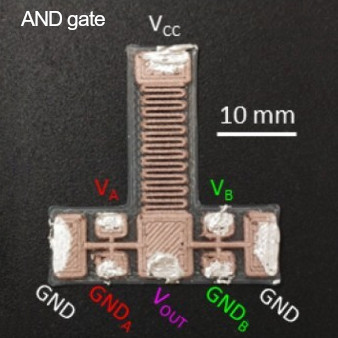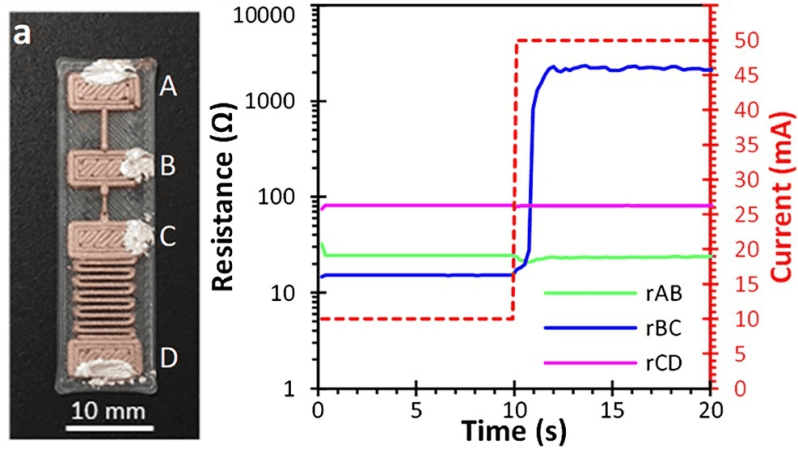One can 3D print with conductive filament, and therefore plausibly create passive components like resistors. But what about active components, which typically require semiconductors? Researchers at MIT demonstrate working concepts for a resettable fuse and logic gates, completely 3D printed and semiconductor-free.
Now just to be absolutely clear — these are still just proofs of concept. To say they are big and perform poorly compared to their semiconductor equivalents would be an understatement. But they do work, and they are 100% 3D printed active electronic components, using commercially-available filament.
How does one make a working resettable fuse and transistor out of such stuff? By harnessing thermal expansion, essentially.
The conductive filament the researchers used is Electrifi by Multi3D, which is PLA combined with copper micro-particles. A segment printed in this filament is normally very conductive due to the densely-packed particles, but as temperature increases (beginning around 40° C) the polymer begins to soften and undergoes thermal expansion. This expansion separates the copper particles, causing a dramatic increase in electrical resistance as electrical pathways are disrupted. That’s pretty neat, but what really ties it together is that this behavior is self-resetting, and reversible. As long as the PLA isn’t straight up melted (that is to say, avoids going over about 150° C) then as the material cools it contracts and restores the conductive pathways to their original low-resistance state. Neat!
So where does the heat required come from? Simply passing enough current through the junction will do the job. By carefully controlling the size and shape of traces (something even hobbyist filament-based 3D printers are very good at) this effect can be made predictable and repeatable.
 The simpler of the two test components uses the resistance spike as a self-resetting fuse. The printed component is designed such that current above a threshold triggers a surge in resistance, preventing damage to some theoretical circuitry downstream. As long as the component is not destroyed by heating it to the point that it melts, it self-resets as it cools.
The simpler of the two test components uses the resistance spike as a self-resetting fuse. The printed component is designed such that current above a threshold triggers a surge in resistance, preventing damage to some theoretical circuitry downstream. As long as the component is not destroyed by heating it to the point that it melts, it self-resets as it cools.
The transistor is a bit more interesting. By designing two paths so that they intersect each other, one can be used as a control path and the other as a signal path. Applying a voltage to the control path electrically controls the resistance of the signal path, effectively acting as a transistor. Researchers combined these basic transistors into NOT, AND, and OR gates. One is shown here.
This whole system is scalable, low-cost, and highly accessible to just about anyone with some basic equipment. Of course, it has some drawbacks. The switching speed is slow (seconds rather than nanoseconds) and being thermally-driven means power consumption is high. Still, it’s pretty nifty stuff. Check out the research paper for all the nitty-gritty details.
We’ve seen 3D printed triboelectric generators so it’s pretty exciting to now see printed active electronic components. Maybe someday they can be combined?
















why?
To print Amigas at home man ! ;)
if you ask that question i am wondering why you are here on this site at all.
If you are wondering why people is asking why? here on Hackaday, then “why” are you here on this site at all. strawberrymortallyb0bcea48e7 had a direct question,what it seems to be ovious for someone is not for the rest of us. That is how we learn.
To run Doom, very slowly.
Why not? Someone thought it was a cool thing to do
We build logic gates as a component of CPUs and memory, so you can use them to make a post on the internet, asking why you want to use them.
Same as the mountain: because it’s there
Well now I’m going to be thinking about how electronics could have been handmade back in the bronze age. Are there circuits embedded in the walls of a dusty cavern somewhere, where someone thousands of years ago mastered non-semiconductor circuitry?
I have spent a non-zero amount of time thinking about how I could reconstruct aspects of modern technology if I ever got somehow sent back into the past.
I would say relais are in the realm of mere people who watched too much Dr Stone.
Hoo boy you are in for a fun (if not highly-credible) rabbit-hole.
there are occasionally ancient ufo remains unearthed. here’s some nanotech from the ural mountains of russia
https://mru.ink/ancient-nanostructures-ural/
Not bronze age, but a guy here on Hackaday wrote some fiction about victorian-era technology, lasers etc. I wish I could give you some more keywords to search :-)
Does this require extremely precise calibration of copper powder to PLA ratio as well as very controlled particle size? So the particles just barely touch, while the plastic is cold…
Other things I’m curious about: how many cycles will it endure before it gets unreliable? And how fast is the switching speed? I suspect both figures are laughably low compared to factory-made transistors (or even old vacuum tubes) but that’s fine–it’s an early concept made of extruded plastic
It’s more of a statistical thing. If you have enough copper particles in there it’s likely that at least x% will touch in a given volume, leading to a typical specific resistance that’s surprisingly reproducible.
From what numbers I can get from the paper, this “switch” seems to take more power to operate than it can switch to downstream devices. Its gain (or fanout, if you wish) is less than unity.
Unless the device can exhibit greater-than-unity power gain its utility as a logic element is, to be kind, limited.
yeah i was reading with bated breath, “how do they make a semiconductor??” and thermal expansion was a big letdown. i’m not sure how it could possibly work but i want to see something more like existing VLSI where the point where two layers cross becomes a transistor :)
When FETs were first invented, they were absolute garbage, so everyone used BJTs. Then FETs got better. Experiments aren’t always about making something useful, but about proving ideas and getting information.
In this case and these days it’s more about getting grant funding, pushing graduate students out the door, and whipping up investor interest. Damn the actual merit.
Since it is basically a logic gate operated by waste heat ruining the conductance of its own elements, no, I doubt it would make a good amplifier. But it is technically a logic gate, and technically you could build a digital circuit with it. No, it would not be efficient. It’s an electronic circuit made of plastic.
Resettable plastic fuses (circuit breakers) using this sort of mechanism have been around for decades. They’ve never gotten much use because of their limitations, one of which is a limit of about 40 volts.
PTC resettable fuses are readily available for line voltage applications; some over 1 kV. Bel Fuse and Littelfuse both have them in their catalog (and a few other manufacturers too), and they are in stock at the usual suppliers.
A thermally operated transistor. I think that is cool (no pun intended) and now wonder whether in history there was anything similar ever concocted. Vacuum tubes? A bimetallic strip transistor. A thermostat comes to mind but that is an on-off switch and controlled by temperature.
A circuit-breaker comes to mind. Has anybody been bored enough to concoct an ALU out of nothing but mains-voltage circuit breakers?
…No, I suppose you’d have to modify them to be self-resetting. You can’t have a human operator going around flipping the lever back over each time one triggers open. Still might be possible if you threw a bunch of springs in there?
It would be so ridiculous you’d be guaranteed a good write-up
How about a relay…